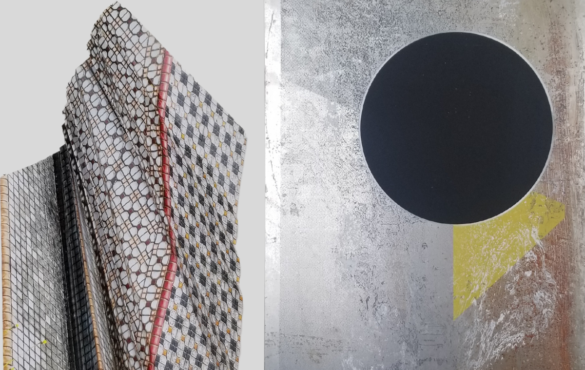Featured Artists:
Farnaz Khosh-Sirat and Hope Wang
Dates:
5/21/2021 – 7/2/2021
Location:
Spudnik Press Cooperative
Events
The Hunger Will Wake Us | Artist Talk & Virtual Reception
Sunday, June 6
1:00 – 2:00 p.m.
Zoom Meeting ID: 9199 0613 028
The Hunger Will Wake Us | Artist-Led Gallery Hours
Sunday, June 13
1:00 – 4:00 p.m.
Press Release:
This exhibition brings together new print work from Hope Wang and Farnaz Khosh-Sirat, who each explore the translational process of materializing digital animations and poetry text into print. Together they reflect on events of displacement through the metaphor of simultaneously losing and finding new meaning and new form via the act of translation.
Hope Wang uses printmaking, handweaving, painting, and photography to reimagine spatial association and visual perception. Wang references the architectural landscape as a malleable document of visual language where building facades become eroded, redacted, and defaced. Farnaz Khosh-Sirat is an Iranian light artist whose work employs digital tools to enhance human experiences of the sublime. Through the use of Persian architectural structures and patterns, Khosh-Sirat personifies human fragility in the contrasting positions between man and nature.
By reconfiguring fragments of hyper-specific architectural details, their works become “false” copies and traces of their constructed memories. These palimpsests’ postures of longing aren’t just decorative, but also serve as coded languages of their own.
Artist Bios:
As an Iranian who has resided in various parts of the world, I am curious about the nuances of sacred spaces in the shifting cultures around me. My work engages the audience in my exploration of spiritual truths, human behavior, healing, and human relationships to the sublime.
I utilize Persian architectural structures and patterns that evoke paradise, and through the use of natural materials such as soil, grass, sugar and natural dyes, I personify human fragility in the c ontrasting positions between man and nature. As questions about technology emerge from the use of digital tools to enhance the human experience in feeling a closer presence with the sublime, I also transform these subjects into animations and video projection-mapped installations.
As my practice progresses, I have begun to question the idea of paradise, and am invested in manipulating light within space to create pause and meditative room to celebrate an honest struggle with truth.
My interest in reimagining spatial association and visual perception scales into observations of trompe l’oeil and its projected desires, codes of spatial authority, and more broadly, how people form complicated relationships with the structures of their daily lives. Contending with sloppy traces of human activity around sites of industrial labour, my work references building facades that have been eroded, redacted, or defaced. I use hand-weaving, screen-printing, painting, and photography to reproduce these architectural “scars” and patterns from common construction materials. By personifying our structural environment as something malleable and flesh-like, I examine contemporary conditions of alienation through mimicry and shifts in material reality.
Through the destabilization of surface and its assumed material conditions, my work questions familiarity as sincerity or as artifice. Engaging provisional aspects of architecture that embody and evade meaning, I am both the skeptic and the nostalgic body: one longing for intimacy and perhaps only finding it in the liminal spaces that belong to nothing in particular.
